Nurses Resilience Simulation: Reflection on Clinical Practice
VerifiedAdded on 2022/10/10
|5
|1050
|369
Homework Assignment
AI Summary
This assignment is a reflection on a nursing student's experience in a resilience simulation workshop. The student cared for an elderly patient with acute on chronic exacerbation of COPD in an acute care setting. The reflection, structured using Gibbs' Reflective Cycle, explores the student's feelings during the simulation, the evaluation of the experience, and an analysis supported by relevant literature on nurses' resilience and burnout, particularly in the context of caring for patients with chronic illnesses. The student discusses the importance of effective clinical handover, and the impact of the simulation on their understanding of resilience, and the need for developing positive attitudes when dealing with patients. The paper concludes with an action plan to bridge the gap between theory and practice, including plans to create more simulation-based education opportunities and incorporate feedback to improve skills, and the need to maintain a healthy relationship with patients at all circumstances.
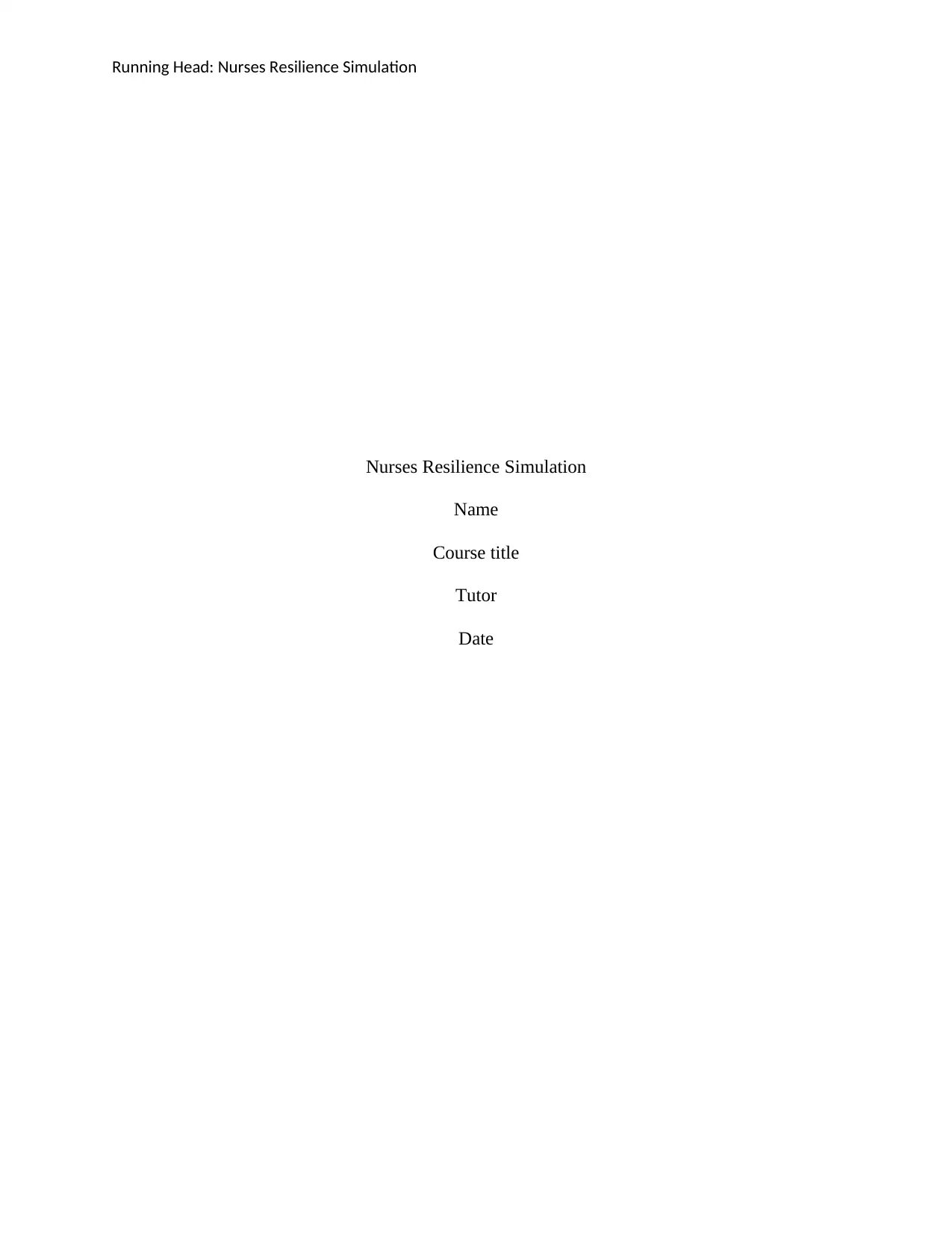
Running Head: Nurses Resilience Simulation
Nurses Resilience Simulation
Name
Course title
Tutor
Date
Nurses Resilience Simulation
Name
Course title
Tutor
Date
Paraphrase This Document
Need a fresh take? Get an instant paraphrase of this document with our AI Paraphraser
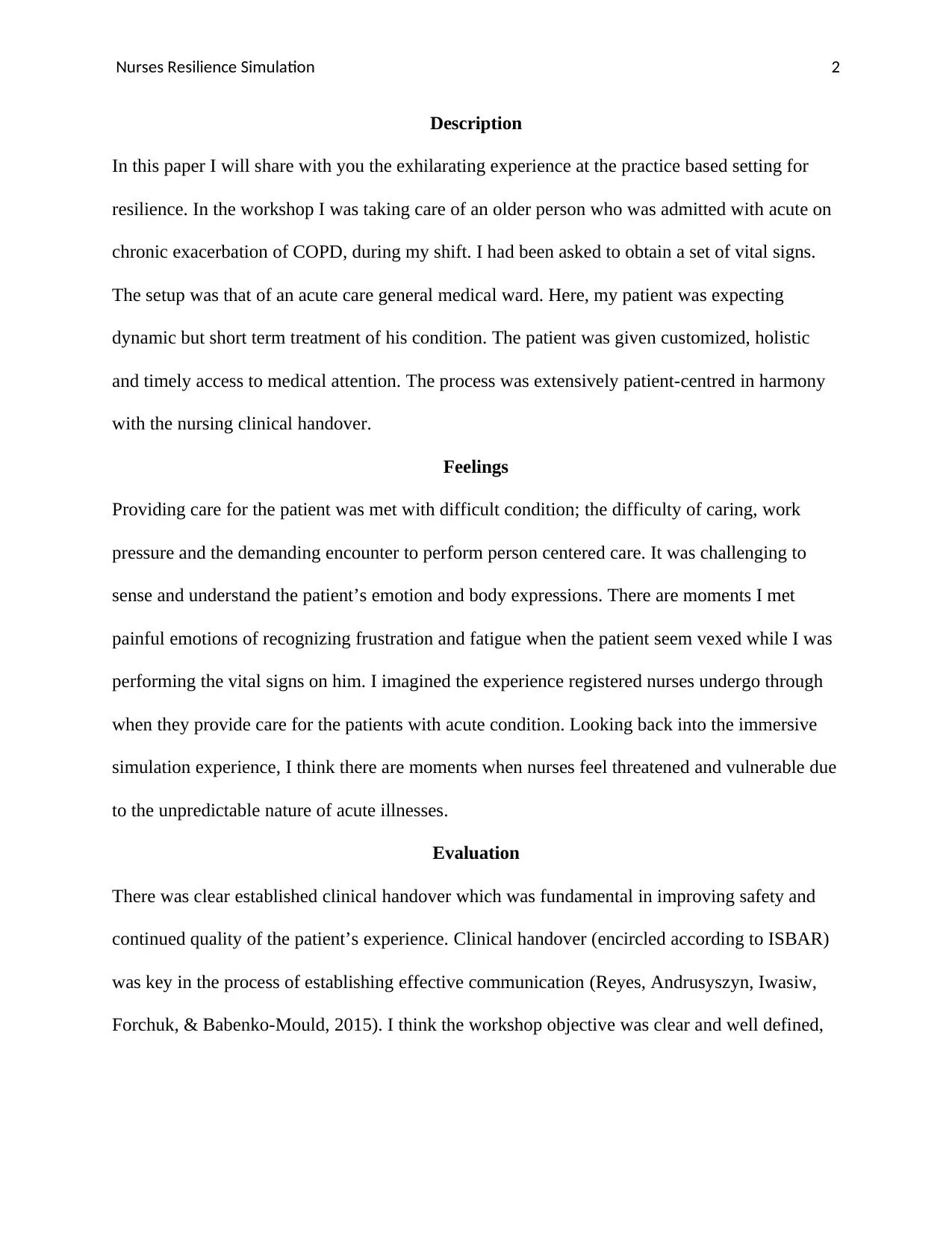
Nurses Resilience Simulation 2
Description
In this paper I will share with you the exhilarating experience at the practice based setting for
resilience. In the workshop I was taking care of an older person who was admitted with acute on
chronic exacerbation of COPD, during my shift. I had been asked to obtain a set of vital signs.
The setup was that of an acute care general medical ward. Here, my patient was expecting
dynamic but short term treatment of his condition. The patient was given customized, holistic
and timely access to medical attention. The process was extensively patient-centred in harmony
with the nursing clinical handover.
Feelings
Providing care for the patient was met with difficult condition; the difficulty of caring, work
pressure and the demanding encounter to perform person centered care. It was challenging to
sense and understand the patient’s emotion and body expressions. There are moments I met
painful emotions of recognizing frustration and fatigue when the patient seem vexed while I was
performing the vital signs on him. I imagined the experience registered nurses undergo through
when they provide care for the patients with acute condition. Looking back into the immersive
simulation experience, I think there are moments when nurses feel threatened and vulnerable due
to the unpredictable nature of acute illnesses.
Evaluation
There was clear established clinical handover which was fundamental in improving safety and
continued quality of the patient’s experience. Clinical handover (encircled according to ISBAR)
was key in the process of establishing effective communication (Reyes, Andrusyszyn, Iwasiw,
Forchuk, & Babenko-Mould, 2015). I think the workshop objective was clear and well defined,
Description
In this paper I will share with you the exhilarating experience at the practice based setting for
resilience. In the workshop I was taking care of an older person who was admitted with acute on
chronic exacerbation of COPD, during my shift. I had been asked to obtain a set of vital signs.
The setup was that of an acute care general medical ward. Here, my patient was expecting
dynamic but short term treatment of his condition. The patient was given customized, holistic
and timely access to medical attention. The process was extensively patient-centred in harmony
with the nursing clinical handover.
Feelings
Providing care for the patient was met with difficult condition; the difficulty of caring, work
pressure and the demanding encounter to perform person centered care. It was challenging to
sense and understand the patient’s emotion and body expressions. There are moments I met
painful emotions of recognizing frustration and fatigue when the patient seem vexed while I was
performing the vital signs on him. I imagined the experience registered nurses undergo through
when they provide care for the patients with acute condition. Looking back into the immersive
simulation experience, I think there are moments when nurses feel threatened and vulnerable due
to the unpredictable nature of acute illnesses.
Evaluation
There was clear established clinical handover which was fundamental in improving safety and
continued quality of the patient’s experience. Clinical handover (encircled according to ISBAR)
was key in the process of establishing effective communication (Reyes, Andrusyszyn, Iwasiw,
Forchuk, & Babenko-Mould, 2015). I think the workshop objective was clear and well defined,
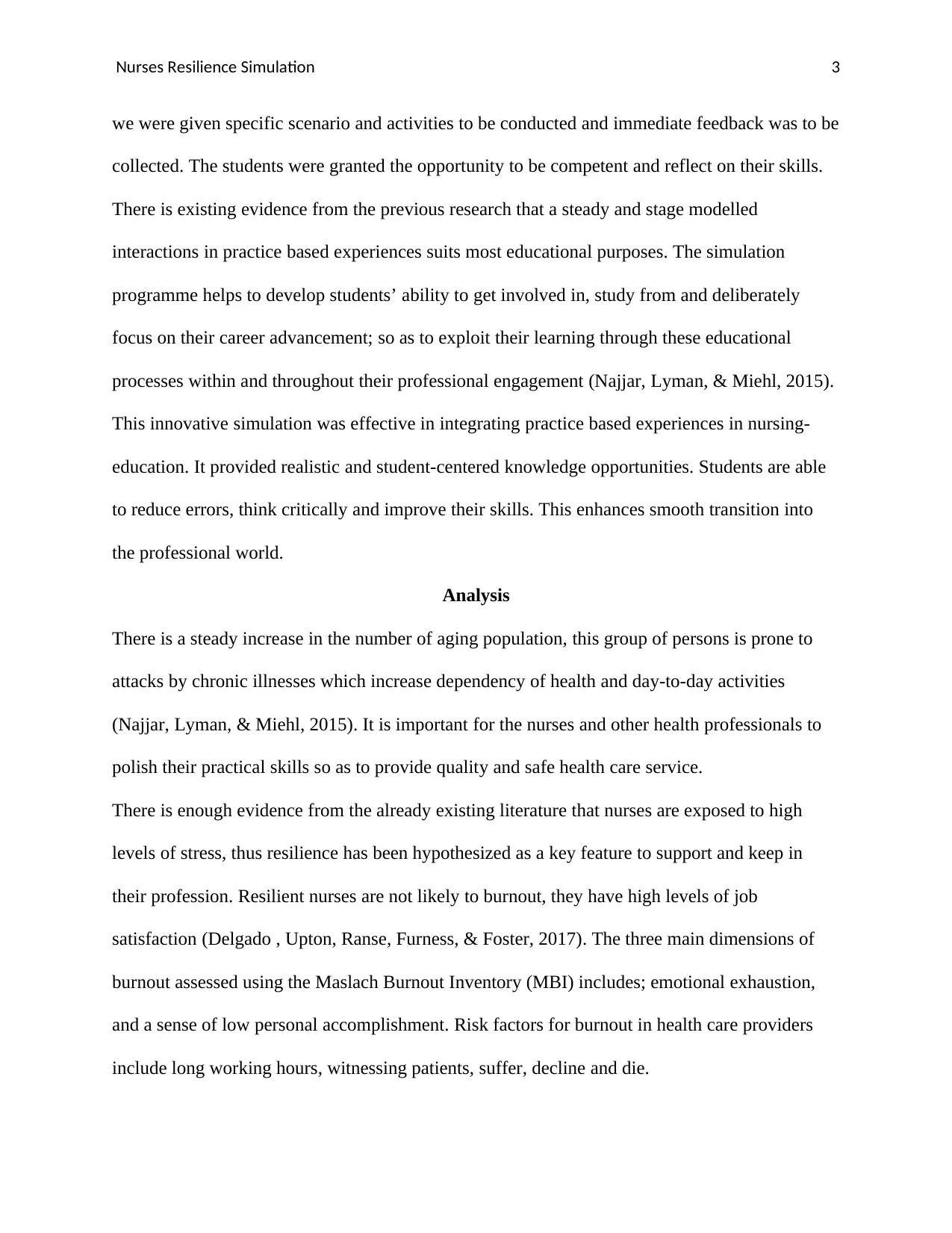
Nurses Resilience Simulation 3
we were given specific scenario and activities to be conducted and immediate feedback was to be
collected. The students were granted the opportunity to be competent and reflect on their skills.
There is existing evidence from the previous research that a steady and stage modelled
interactions in practice based experiences suits most educational purposes. The simulation
programme helps to develop students’ ability to get involved in, study from and deliberately
focus on their career advancement; so as to exploit their learning through these educational
processes within and throughout their professional engagement (Najjar, Lyman, & Miehl, 2015).
This innovative simulation was effective in integrating practice based experiences in nursing-
education. It provided realistic and student-centered knowledge opportunities. Students are able
to reduce errors, think critically and improve their skills. This enhances smooth transition into
the professional world.
Analysis
There is a steady increase in the number of aging population, this group of persons is prone to
attacks by chronic illnesses which increase dependency of health and day-to-day activities
(Najjar, Lyman, & Miehl, 2015). It is important for the nurses and other health professionals to
polish their practical skills so as to provide quality and safe health care service.
There is enough evidence from the already existing literature that nurses are exposed to high
levels of stress, thus resilience has been hypothesized as a key feature to support and keep in
their profession. Resilient nurses are not likely to burnout, they have high levels of job
satisfaction (Delgado , Upton, Ranse, Furness, & Foster, 2017). The three main dimensions of
burnout assessed using the Maslach Burnout Inventory (MBI) includes; emotional exhaustion,
and a sense of low personal accomplishment. Risk factors for burnout in health care providers
include long working hours, witnessing patients, suffer, decline and die.
we were given specific scenario and activities to be conducted and immediate feedback was to be
collected. The students were granted the opportunity to be competent and reflect on their skills.
There is existing evidence from the previous research that a steady and stage modelled
interactions in practice based experiences suits most educational purposes. The simulation
programme helps to develop students’ ability to get involved in, study from and deliberately
focus on their career advancement; so as to exploit their learning through these educational
processes within and throughout their professional engagement (Najjar, Lyman, & Miehl, 2015).
This innovative simulation was effective in integrating practice based experiences in nursing-
education. It provided realistic and student-centered knowledge opportunities. Students are able
to reduce errors, think critically and improve their skills. This enhances smooth transition into
the professional world.
Analysis
There is a steady increase in the number of aging population, this group of persons is prone to
attacks by chronic illnesses which increase dependency of health and day-to-day activities
(Najjar, Lyman, & Miehl, 2015). It is important for the nurses and other health professionals to
polish their practical skills so as to provide quality and safe health care service.
There is enough evidence from the already existing literature that nurses are exposed to high
levels of stress, thus resilience has been hypothesized as a key feature to support and keep in
their profession. Resilient nurses are not likely to burnout, they have high levels of job
satisfaction (Delgado , Upton, Ranse, Furness, & Foster, 2017). The three main dimensions of
burnout assessed using the Maslach Burnout Inventory (MBI) includes; emotional exhaustion,
and a sense of low personal accomplishment. Risk factors for burnout in health care providers
include long working hours, witnessing patients, suffer, decline and die.
⊘ This is a preview!⊘
Do you want full access?
Subscribe today to unlock all pages.

Trusted by 1+ million students worldwide
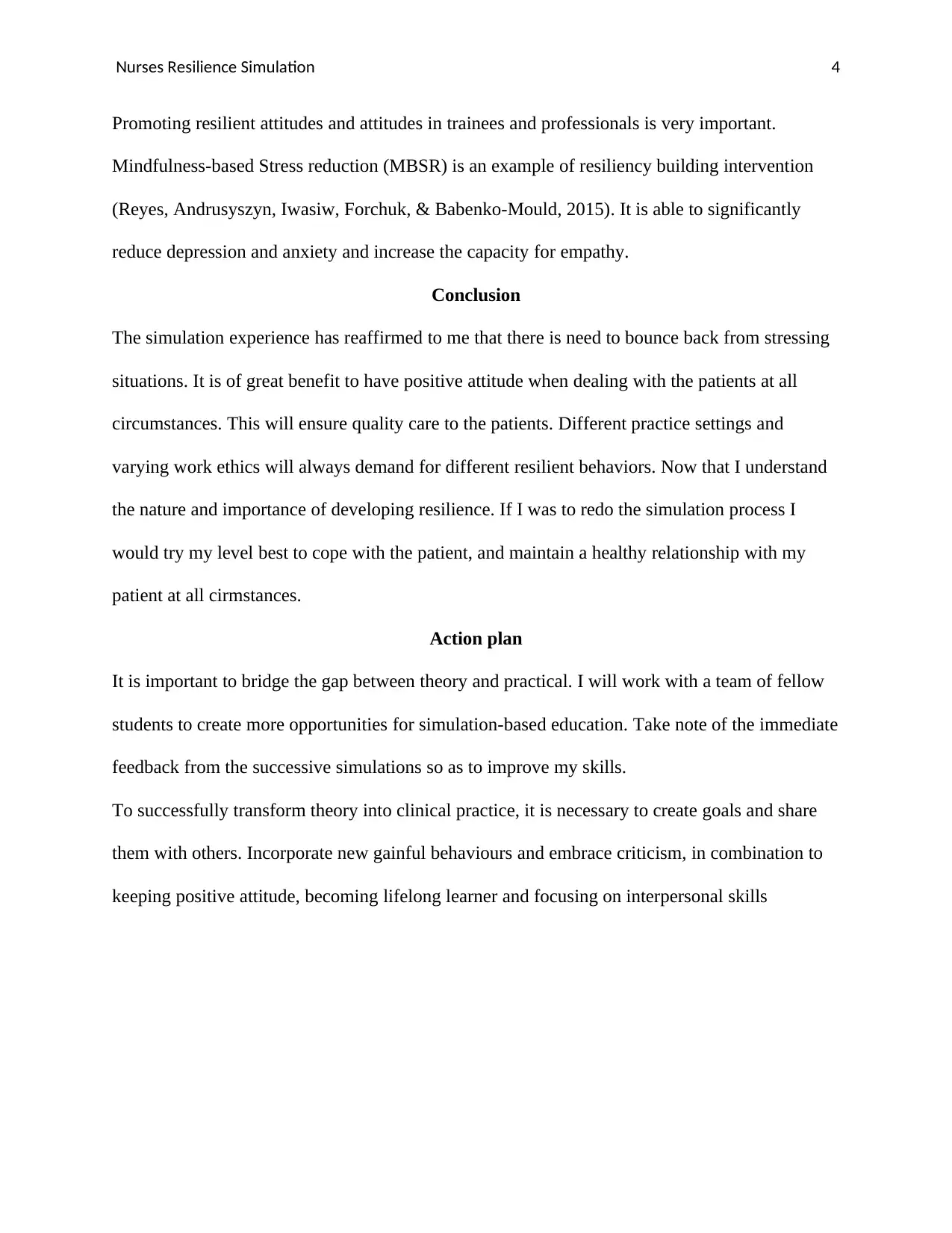
Nurses Resilience Simulation 4
Promoting resilient attitudes and attitudes in trainees and professionals is very important.
Mindfulness-based Stress reduction (MBSR) is an example of resiliency building intervention
(Reyes, Andrusyszyn, Iwasiw, Forchuk, & Babenko-Mould, 2015). It is able to significantly
reduce depression and anxiety and increase the capacity for empathy.
Conclusion
The simulation experience has reaffirmed to me that there is need to bounce back from stressing
situations. It is of great benefit to have positive attitude when dealing with the patients at all
circumstances. This will ensure quality care to the patients. Different practice settings and
varying work ethics will always demand for different resilient behaviors. Now that I understand
the nature and importance of developing resilience. If I was to redo the simulation process I
would try my level best to cope with the patient, and maintain a healthy relationship with my
patient at all cirmstances.
Action plan
It is important to bridge the gap between theory and practical. I will work with a team of fellow
students to create more opportunities for simulation-based education. Take note of the immediate
feedback from the successive simulations so as to improve my skills.
To successfully transform theory into clinical practice, it is necessary to create goals and share
them with others. Incorporate new gainful behaviours and embrace criticism, in combination to
keeping positive attitude, becoming lifelong learner and focusing on interpersonal skills
Promoting resilient attitudes and attitudes in trainees and professionals is very important.
Mindfulness-based Stress reduction (MBSR) is an example of resiliency building intervention
(Reyes, Andrusyszyn, Iwasiw, Forchuk, & Babenko-Mould, 2015). It is able to significantly
reduce depression and anxiety and increase the capacity for empathy.
Conclusion
The simulation experience has reaffirmed to me that there is need to bounce back from stressing
situations. It is of great benefit to have positive attitude when dealing with the patients at all
circumstances. This will ensure quality care to the patients. Different practice settings and
varying work ethics will always demand for different resilient behaviors. Now that I understand
the nature and importance of developing resilience. If I was to redo the simulation process I
would try my level best to cope with the patient, and maintain a healthy relationship with my
patient at all cirmstances.
Action plan
It is important to bridge the gap between theory and practical. I will work with a team of fellow
students to create more opportunities for simulation-based education. Take note of the immediate
feedback from the successive simulations so as to improve my skills.
To successfully transform theory into clinical practice, it is necessary to create goals and share
them with others. Incorporate new gainful behaviours and embrace criticism, in combination to
keeping positive attitude, becoming lifelong learner and focusing on interpersonal skills
Paraphrase This Document
Need a fresh take? Get an instant paraphrase of this document with our AI Paraphraser
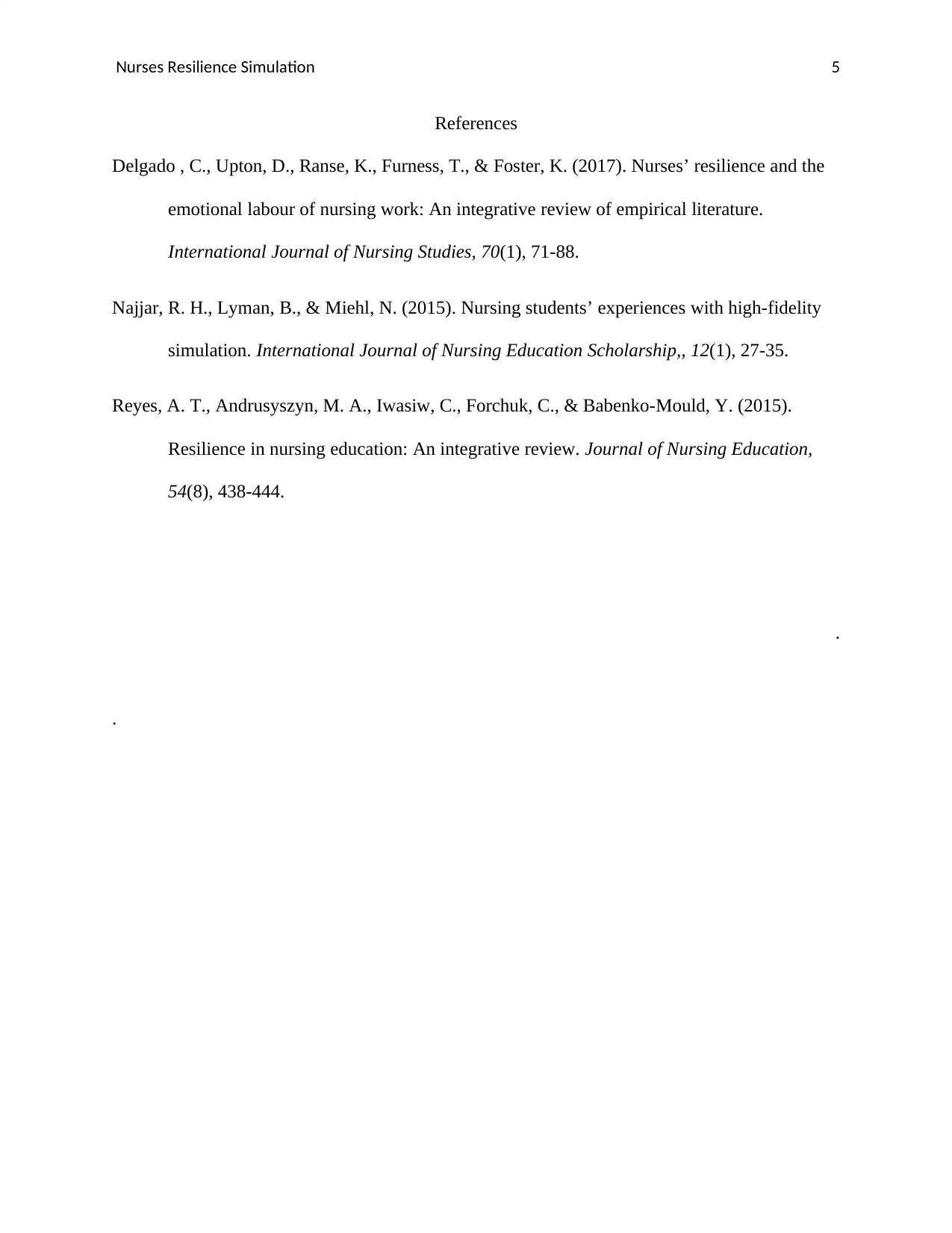
Nurses Resilience Simulation 5
References
Delgado , C., Upton, D., Ranse, K., Furness, T., & Foster, K. (2017). Nurses’ resilience and the
emotional labour of nursing work: An integrative review of empirical literature.
International Journal of Nursing Studies, 70(1), 71-88.
Najjar, R. H., Lyman, B., & Miehl, N. (2015). Nursing students’ experiences with high-fidelity
simulation. International Journal of Nursing Education Scholarship,, 12(1), 27-35.
Reyes, A. T., Andrusyszyn, M. A., Iwasiw, C., Forchuk, C., & Babenko-Mould, Y. (2015).
Resilience in nursing education: An integrative review. Journal of Nursing Education,
54(8), 438-444.
.
.
References
Delgado , C., Upton, D., Ranse, K., Furness, T., & Foster, K. (2017). Nurses’ resilience and the
emotional labour of nursing work: An integrative review of empirical literature.
International Journal of Nursing Studies, 70(1), 71-88.
Najjar, R. H., Lyman, B., & Miehl, N. (2015). Nursing students’ experiences with high-fidelity
simulation. International Journal of Nursing Education Scholarship,, 12(1), 27-35.
Reyes, A. T., Andrusyszyn, M. A., Iwasiw, C., Forchuk, C., & Babenko-Mould, Y. (2015).
Resilience in nursing education: An integrative review. Journal of Nursing Education,
54(8), 438-444.
.
.
1 out of 5
Related Documents
Your All-in-One AI-Powered Toolkit for Academic Success.
+13062052269
info@desklib.com
Available 24*7 on WhatsApp / Email
![[object Object]](/_next/static/media/star-bottom.7253800d.svg)
Unlock your academic potential
Copyright © 2020–2025 A2Z Services. All Rights Reserved. Developed and managed by ZUCOL.





